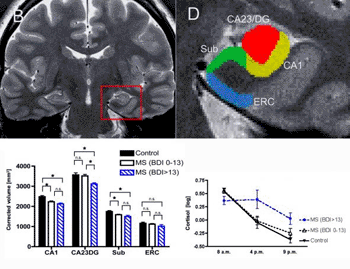MRI and Automated Surface Mesh Modeling Analysis Reveal Changes in Brain Anatomy in Women with Multiple Sclerosis and Depression
By MedImaging International staff writers
Posted on 13 Feb 2014
A multicenter team of US investigators are using a new, automated technique to identify shrinkage of a mood-regulating brain structure in a large study sample of women with multiple sclerosis (MS), who also have a specific type of depression.Posted on 13 Feb 2014
Women with MS, in the study, and symptoms of “depressive affect,” such as depressed mood and loss of interest, were found to have reduced size of the right hippocampus. The left hippocampus remained unchanged and other types of depression, such as vegetative depression, which can bring about extreme fatigue, did not correlate with hippocampal size reduction, according to an article published in the January 2014 issue of the journal Human Brain Mapping.

Image: MS Atrophy. Brain images showing location of hippocampus and its sub-regions in the brain. Bar graph shows atrophy within these specific hippocampal subregions. Black bars represent the control group; white bars represent people with MS who are not depressed; striped bars represent people with MS and depression (Photo courtesy of University of California - Los Angeles).
This new study, led by Cedars-Sinai Medical Center (Los Angeles, CA, USA) neurologist Nancy Sicotte, MD, an expert in multiple sclerosis (MS) and cutting-edge imaging techniques, confirms earlier research suggesting that the hippocampus may be a contributor to the high frequency of depression in MS. Furthermore, it also revealed that a computer imaging technique called automated surface mesh modeling can promptly identify thickness alterations in subregions of the hippocampus. Before this, the process required a labor-intensive manual analysis of magnetic resonance imaging (MRI) images.
Dr. Sicotte, the article’s senior author, and others have earlier found evidence of tissue loss in the hippocampus, however, the changes could only be validated in manual tracings of a set of special high-resolution MRI images. The new application can use more easily obtainable MRI scans and it automates the brain mapping process. “Patients with medical disorder and in particular, those with inflammatory diseases such as MS, often suffer from depression, which can cause fatigue. But not all fatigue is caused by depression. We believe that while fatigue and depression often co-occur in patients with MS, they may be brought about by different biological mechanisms. Our studies are designed to help us better understand how MS-related depression differs from other types, improve diagnostic imaging systems to make them more widely available and efficient, and create better, more individualized treatments for our patients,” said Dr. Sicotte, director of Cedars-Sinai’s Multiple Sclerosis Program and the Neurology Residency Program.
Related Links:
Cedars-Sinai Medical Center












.jpg)

